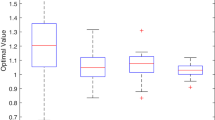Abstract
We develop a new modeling and solution method for stochastic programming problems that include a joint probabilistic constraint in which the multirow random technology matrix is discretely distributed. We binarize the probability distribution of the random variables in such a way that we can extract a threshold partially defined Boolean function (pdBf) representing the probabilistic constraint. We then construct a tight threshold Boolean minorant for the pdBf. Any separating structure of the tight threshold Boolean minorant defines sufficient conditions for the satisfaction of the probabilistic constraint and takes the form of a system of linear constraints. We use the separating structure to derive three new deterministic formulations for the studied stochastic problem, and we derive a set of strengthening valid inequalities. A crucial feature of the new integer formulations is that the number of integer variables does not depend on the number of scenarios used to represent uncertainty. The computational study, based on instances of the stochastic capital rationing problem, shows that the mixed-integer linear programming formulations are orders of magnitude faster to solve than the mixed-integer nonlinear programming formulation. The method integrating the valid inequalities in a branch-and-bound algorithm has the best performance.


Similar content being viewed by others
References
Adams, W.P., Sherali, H.G.: Mixed-integer bilinear programming problems. Math. Program. 59(1–3), 279–305 (1993)
Belotti, P.: Couenne: A User’s Nanual. Technical Report, Lehigh University (2009)
Beraldi, P., Bruni, M.E.: An exact approach for solving integer problems under probabilistic constraints with random technology matrix. Ann. Oper. Res. 177(1), 127–137 (2010)
Beraldi, P., Bruni, M.E., Violi, A.: Capital rationing problems under uncertainty and risk. Comput. Optim. Appl. 51(3), 1375–1396 (2012)
Bonami, P., Lejeune, M.A.: An exact solution approach for portfolio optimization problems under stochastic and integer constraints. Oper. Res. 57(3), 650–670 (2009)
Boros, E., Hammer, P.L., Ibaraki, T., Kogan, A.: Logical analysis of numerical data. Math. Program. 79(1–3), 163–190 (1997)
Costa, A., Paixao, J.M.P.: An approximate solution approach for a scenario-based capital budgeting model. Comput. Manag. Sci. 7(3), 337–353 (2010)
Crama, Y., Hammer, P.L.: Boolean Functions: Theory, Algorithms, and Applications. Cambridge Press University, Cambridge, MA (2011)
Genz, A., Bretz, F.: Computation of Multivariate Normal and \(t\) Probabilities. Lecture Notes in Statistics 195. Springer, Dordrecht (2009)
Glover, F.: Improved linear integer programming formulations of nonlinear integer problems. Manag. Sci. 22(4), 455–460 (1975)
Gurgur, C.Z., Luxhoj, J.T.: Application of chance-constrained programming to capital rationing problems with asymmetrically distributed cash flows and available budgets. Eng. Econ. 48(3), 241–258 (2003)
Henrion, R.: Structural properties of linear probabilistic constraints. Optimization 56(4), 425–440 (2007)
Henrion, R., Strugarek, C.: Convexity of chance constraints with independent random variables. Comput. Optim. Appli. 41(2), 263–276 (2008)
Kataoka, S.: A stochastic programming model. Econometrica 31(1–2), 181–196 (1963)
Khan, A.: Capital budgeting under capital rationing: an analytical overview of optimization models for government. Int. J. Public Adm. 31(2), 168–194 (2008)
Lejeune, M.A.: A VaR Black–Litterman model for the construction of absolute return fund-of-funds. Quant. Financ. 11(10), 639–664 (2011)
Lejeune, M.A.: Pattern-based modeling and solution of probabilistically constrained optimization problems. Oper. Res. 60(6), 1356–1372 (2012)
Lejeune, M.A.: Pattern definition of the \(p\)-efficiency concept. Ann. Oper. Res. 200(1), 23–36 (2012)
Lorie, J.H., Savage, L.J.: Three problems in rationing capital. J. Bus. 28(2), 229–239 (1955)
Luedtke, J., Ahmed, S.: A sample approximation approach for optimization with probabilistic constraints. SIAM J. Optim. 19(2), 674–699 (2008)
Mukherjee, T., Hingorani, V.: Capital-rationing decisions of fortune 500 firms: a survey. Financ. Pract. Educ. 9(1), 7–15 (1999)
Muroga, S.: Threshold Logic and Its Applications. Wiley, New York, NY (1971)
Naslund, B.: A model of capital budgeting under risk. J. Bus. 39(2), 257–271 (1966)
Prékopa, A.: Programming under probabilistic constraints with a random technology matrix. Math. Oper. Stat. 5(2), 109–116 (1974)
Prékopa, A.: Stochastic Programming. Kluwer, Boston, MA (1995)
Prékopa, A.: Probabilistic programming models. Chapter 5. In: Ruszczyński, A., Shapiro, A. (eds.) Stochastic Programming: Handbook in Operations Research and Management Science, vol. 10, pp. 267–351. Elsevier, Amsterdam (2003)
Prékopa, A., Yoda, K., Subasi, M.: Uniform quasi-concavity in probabilistic constrained stochastic programming. Oper. Res. Lett. 39(3), 188–192 (2011)
Ruszczyński, A.: Probabilistic programming with discrete distribution and precedence constrained knapsack polyhedra. Math. Program. 93(2), 195–215 (2002)
Sarper, H.: Capital rationing under risk: a chance-constrained approach using uniformly distributed cash flows and available budgets. Eng. Econ. 39(1), 49–76 (1993)
Tanner, M.W., Ntaimo, L.: IIS branch-and-cut for joint chance-constrained stochastic programs and application to optimal vaccine allocation. Eur. J. Oper. Res. 207(1), 290–296 (2010)
van Ackooij, W., Henrion, R., Moller, A., Zorgati, R.: On joint probabilistic constraints with Gaussian coefficient matrix. Oper. Res. Lett. 39(2), 99–102 (2011)
van de Panne, C., Popp, W.: Minimum-cost cattle feed under probabilistic constraints. Manag. Sci. 9(3), 405–430 (1963)
Acknowledgments
The authors are grateful to the valuable comments and suggestions from two anonymous reviewers and from the associate editor of the Stochastic Programming E-Print Series (SPEPS), who helped improve the paper significantly. M. Lejeune is partially supported by the Army Research Office under Grant # W911NF-09-1-0497.
Author information
Authors and Affiliations
Corresponding author
Rights and permissions
About this article
Cite this article
Kogan, A., Lejeune, M.A. Threshold Boolean form for joint probabilistic constraints with random technology matrix. Math. Program. 147, 391–427 (2014). https://doi.org/10.1007/s10107-013-0728-y
Received:
Accepted:
Published:
Issue Date:
DOI: https://doi.org/10.1007/s10107-013-0728-y
Keywords
- Stochastic programming
- Boolean function
- Joint probabilistic constraint
- Random technology matrix
- Minorant
- Threshold function




